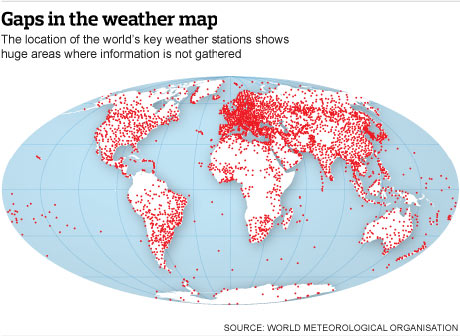They may be missing half the earth, but they can still measure the earth’s temperature accurately to within one hundredth of a degree.
http://www.guardian.co.uk/science/2010/sep/05/google-galaxy-zoo-climate-project
Climate scientists meeting in Britain this week hope to build a database to predict natural disasters precisely. And records of the voyages of the Bounty and Beagle will assist them in their task.
The Met Office eliminated a natural disaster last year, by dropping their seasonal forecasts.
Leading climate scientists will gather in the UK this week to finalise plans for a revolutionary project aimed at transforming their ability to predict meteorological disasters. The goal is to create an international databank that would generate forecasts of unprecedented precision.
Ah … now we understand why hurricane forecasting is so inaccurate. It is because they don’t have an “international databank.”
The scientists’ plans include: Creating a global network of weather stations that would provide daily temperature readings for any spot on the planet. At present, only monthly readings are generated for the United States and Europe, while virtually no data is provided for much of Africa, the Amazon and Antarctica.
We don’t need no stinking satellites. As long as there is a thermometer within 1200 km, we should be OK.
“It is now very clear that humanity is changing the climate through the greenhouse gases we are pumping into the atmosphere,” said Peter Stott, head of climate monitoring at the UK Met Office, one of the organisers of this week’s meeting. “But we don’t know yet, and what we really must find out is how those changes will affect a particular area.
Evil CO2 Pump




In the real world inhabited by hard working productive people, you fail, you’re fired.
In the fantasy world of government entities, you fail, you invoke the 2 response solution:
— I need more money.
— I need more power.
And repreat as often as needed — new fiscal year or new crisis. True for economic advisors or science advisors.
“They may be missing half the earth, but they can still measure the earth’s temperature accurately to within one hundredth of a degree.”
1. LAND not globe. Those dots are land stations.
2. Nobody claims accuracy to 1/100th of a degree.
Had Crut reports to thousandths of a degree
2010 0.488 0.471 0.572 0.559 0.509 0.521 0.526
http://www.cru.uea.ac.uk/cru/data/temperature/hadcrut3vgl.txt
GISTEMP reports to hundredths of a degree
http://data.giss.nasa.gov/gistemp/tabledata/GLB.Ts+dSST.txt
2010 70 75 84 76 65 58 55
Steven Mosher,
I get it now. You think it is OK for Hansen to call land stations the globe but not OK for me to call them the earth.
Steve Mosher – when GISS (or any of the outfits) are declaring year X the hotest on record by “.01” degrees, they are indeed claiming accuracy to the 100ths.
Link for that dotmap?
(dots are on seas,too…)
It is from the same Guardian article linked above
http://www.guardian.co.uk/science/2010/sep/05/google-galaxy-zoo-climate-project
Earth surface; land 30% oceans 70%. Land surface has large differences and variations in temperature over relatively short distances. Ocean temperatures are much more evenly spread over large areas with a much closer temperature range. Would you replicate the red dots on land two fold, and float them as thermometers in the ocean? Measured with 1/100 of a degree accuracy? Who’s claim is that? Yours?
Had Crut reports to thousandths of a degree
2010 0.488 0.471 0.572 0.559 0.509 0.521 0.526
http://www.cru.uea.ac.uk/cru/data/temperature/hadcrut3vgl.txt
GISTEMP reports to hundredths of a degree
http://data.giss.nasa.gov/gistemp/tabledata/GLB.Ts+dSST.txt
2010 70 75 84 76 65 58 55
Re Had Crut; “In the hemispheric files averages are now given to a precision of three decimal places to enable seasonal values to be calculated to ±0.01°C. The extra precision implies no greater accuracy than two decimal places.”
http://www.cru.uea.ac.uk/cru/data/temperature/
Re both Had Crut and GISS, these are not individual thermometer measurements but a calculated temperature from multiple measurements of a grid area to arrive at an average for that area. Using two or three decimal points seems perfectly adequate. I don’t know of any thermometers accurate to 1/000th of a degree, not even my thermo-couple device.
Isn’t that the bird flue map?
I meant flu of course. (or, since it was birds, did I mean flew?)